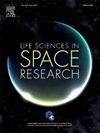对多个国际空间站和月球任务的宇航员的非目标效应和空间辐射风险
IF 2.9
3区 生物学
Q2 ASTRONOMY & ASTROPHYSICS
引用次数: 2
摘要
未来到地球、月球或火星的太空旅行很可能导致选择有经验的国际空间站(ISS)或月球机组人员参加随后的月球或火星任务。太空旅行的主要风险是银河宇宙射线(GCR)引起癌症、循环系统疾病和认知损害的风险。然而,与低LET辐射相比,由于重离子微观能量沉积的定量和定性差异导致生物效应的差异,风险预测存在很大的不确定性。此外,重离子和其他高LET辐射的放射生物学资料较少,流行病学资料缺乏。在放射生物学研究中发现了非靶向效应(NTEs),以增加低剂量高let辐射对癌症相关终点的生物学有效性。在本文中,使用最新版本的NASA太空癌症风险模型(NSCR-2022)来预测任务风险,同时考虑nte在固体癌症风险预测中的作用。我讨论了美国白人和美国亚太岛民(API)人口在6个月的国际空间站,80天的月球任务和联合国际空间站-月球任务人员的癌症和循环系统疾病死亡率的空间辐射风险的预测。结果预测NTE比忽略NTE的模型增加了约2.3倍的癌症风险。据预测,与美国白人相比,美国黑人患癌症的风险约为30%。癌症风险略低于多重任务的累加性风险,这是由于随着辐射风险的增加,与背景风险的竞争加剧。在忽略nte的模型中,纳入循环系统风险会使女性和男性的死亡率分别增加约25%和37%,在假设nte会改变实体癌风险时,死亡率分别增加20%和30%。这里对国际空间站和月球联合任务的预测表明,风险在NCRP对此类任务的风险限制建议范围内。本文章由计算机程序翻译,如有差异,请以英文原文为准。
Non-Targeted Effects and Space Radiation Risks for Astronauts on Multiple International Space Stations and Lunar Missions
Future space travel to the earths moon or the planet mars will likely lead to the selection of experienced International Space Station (ISS) or lunar crew persons for subsequent lunar or Mars missions. The major risk for space travel is the galactic cosmic rays (GCR) risks of cancer, circulatory diseases and detriments in cognition. However large uncertainties in risk prediction occur due to the quantitative and qualitative differences in heavy ion microscopic energy deposition leading to differences in biological effects compared to low LET radiation. In addition, there are sparse radiobiology data and absence of epidemiology data for heavy ions and other high LET radiation. Non-targeted effects (NTEs) are found in radiobiology studies to increase the biological effectiveness of high let radiation at low dose for cancer related endpoints. In this paper the most recent version of the NASA Space Cancer Risk model (NSCR-2022) is used to predict mission risks while considering NTEs in solid cancer risk predictions. I discuss predictions of space radiation risks of cancer and circulatory disease mortality for US Whites and US Asian-Pacific Islander (API) populations for 6-month ISS, 80-day lunar missions, and combined ISS-lunar mission crews are made. Results predict NTE increase cancer risks by about ~2.3 fold over a model that ignores NTEs. US API are predicted to have a lower cancer risks of about 30% compared to US Whites. Cancer risks are slightly less than additive for multiple missions, which is due to the increased competition with background risks as radiation risks increase. The inclusion of circulatory risks increases mortality estimates about 25% and 37% for females and males, respectively in the model ignoring NTEs, and 20% and 30% when NTEs are assumed to modify solid cancer risk. The predictions made here for combined ISS and lunar missions suggest risks are within risk limit recommendations of the NCRP for such missions.
求助全文
通过发布文献求助,成功后即可免费获取论文全文。
去求助
来源期刊

Life Sciences in Space Research
Agricultural and Biological Sciences-Agricultural and Biological Sciences (miscellaneous)
CiteScore
5.30
自引率
8.00%
发文量
69
期刊介绍:
Life Sciences in Space Research publishes high quality original research and review articles in areas previously covered by the Life Sciences section of COSPAR''s other society journal Advances in Space Research.
Life Sciences in Space Research features an editorial team of top scientists in the space radiation field and guarantees a fast turnaround time from submission to editorial decision.
 求助内容:
求助内容: 应助结果提醒方式:
应助结果提醒方式:


